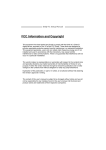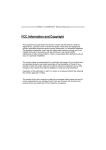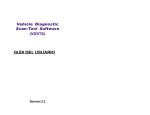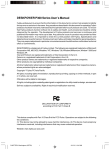Download Biostar J1800NH2 motherboard
Transcript
J1800NH2/J1900NH2/J2900NH2 UEFI BIOS Manual UEFI BIOS Setup ........................................................................... 1 1 Main Menu................................................................................... 3 2 Advanced Menu.......................................................................... 4 3 Chipset Menu............................................................................ 17 4 Security Menu........................................................................... 21 5 Performance Menu ................................................................... 23 6 Boot Menu................................................................................. 25 7 Exit Menu .................................................................................. 26 i J1800NH2/J1900NH2/J2900NH2 UEFI BIOS Manual UEFI BIOS Setup Introduction The purpose of this manual is to describe the settings in the AMI UEFI BIOS Setup program on this motherboard. The Setup program allows users to modify the basic system configuration and save these settings to NVRAM. UEFI BIOS determines what a computer can do without accessing programs from a disk. This system controls most of the input and output devices such as keyboard, mouse, serial ports and disk drives. BIOS activates at the first stage of the booting process, loading and executing the operating system. Some additional features, such as virus and password protection or chipset fine-tuning options are also included in UEFI BIOS. The rest of this manual will to guide you through the options and settings in UEFI BIOS Setup. Plug and Play Support This AMI UEFI BIOS supports the Plug and Play Version 1.0A specification. EPA Green PC Support This AMI UEFI BIOS supports Version 1.03 of the EPA Green PC specification. ACPI Support AMI ACPI UEFI BIOS support Version 1.0/2.0 of Advanced Configuration and Power interface specification (ACPI). It provides ASL code for power management and device configuration capabilities as defined in the ACPI specification, developed by Microsoft, Intel and Toshiba. PCI Bus Support This AMI UEFI BIOS also supports Version 2.3 of the Intel PCI (Peripheral Component Interconnect) local bus specification. DRAM Support DDR3L SO-DRAM (Double Data Rate III Synchronous DRAM) is supported. 1 J1800NH2/J1900NH2/J2900NH2 UEFI BIOS Manual Using Setup When starting up the computer, press <Del> during the Power-On Self-Test (POST) to enter the UEFI BIOS setup utility. In the UEFI BIOS setup utility, you will see General Help description at the top right corner, and this is providing a brief description of the selected item. Navigation Keys for that particular menu are at the bottom right corner, and you can use these keys to select item and change the settings. General Help Navigation Keys Notice z The default UEFI BIOS settings apply for most conditions to ensure optimum performance of the motherboard. If the system becomes unstable after changing any settings, please load the default settings to ensure system’s compatibility and stability. Use Load Setup Default under the Exit Menu. z For better system performance, the UEFI BIOS firmware is being continuously updated. The UEFI BIOS information described in this manual is for your reference only. The actual UEFI BIOS information and settings on board may be slightly different from this manual. z The content of this manual is subject to be changed without notice. We will not be responsible for any mistakes found in this user’s manual and any system damage that may be caused by wrong-settings. 2 J1800NH2/J1900NH2/J2900NH2 UEFI BIOS Manual 1 Main Menu Once you enter AMI UEFI BIOS Setup Utility, the Main Menu will appear on the screen providing an overview of the basic system information. BIOS Information It shows system information including UEFI BIOS version, Project Code, Model Name, Build Date and etc. Total Memory Shows system memory size, VGA shard memory will be excluded. System Language Choose the system default language. System Date Set the system date. Note that the ‘Day’ automatically changes when you set the date. System Time Set the system internal clock. 3 J1800NH2/J1900NH2/J2900NH2 UEFI BIOS Manual 2 Advanced Menu The Advanced Menu allows you to configure the settings of CPU, Super I/O, Power Management, and other system devices. Notice Beware of that setting inappropriate values in items of this menu may cause system to malfunction. ACPI Settings Enable ACPI Auto Configuration This item enables or disables BIOS ACPI Auto Configuration. Options: Disabled (Default) / Enabled 4 J1800NH2/J1900NH2/J2900NH2 UEFI BIOS Manual Enable Hibernation This item enables or disables system ability to hibernate (OS/S4 Sleep State). This option may be not effective with some OSes. Options: Enabled (Default) / Disabled ACPI Sleep State This item selects the highest ACPI sleep state the system will enter when the SUSPEND button is pressed. Options: S3 only (Suspend to RAM) (Default) / Suspend Disabled Lock Legacy Resources The item enables or disables Lock of Legacy Resources. Options: Disabled (Default) / Enabled Ring-In Wake up from S5 This item enables the system to wake from S5 using Ring-In event. Options: Disabled (Default) / Enabled PS2 Keyboard PowerOn This item allows you to control the keyboard power on function. Options: Disabled (Default) / Any Key / Stroke Key / Specific Key Stroke Keys This item will show only when Keyboard PowerOn is set “Stroke Key.” Options: Wake Key (Default) / Power Key / Ctrl+F1 / Ctrl+F2 / Ctrl+F3 / Ctrl +F4 / Ctrl+F5 / Ctrl+F6 Specific Key This item will show only when Keyboard PowerOn is set “Specific Key.” Press Enter to set Specific key. PS2 Mouse PowerOn This item allows you to control the mouse power on function. Options: Disabled (Default) / Enabled Restore AC Power Loss Specify what state to go to when power is re-applied after a power failure. Options: Power Off (Default) / Power On / Last State EuP Control When EuP is enabled, the system will meet EuP requirement. Options: Disabled (Default) / Enabled PME Wake up from S5 The item enables the system to wake from S5 using PME event. Options: Disabled (Default) / Enabled 5 J1800NH2/J1900NH2/J2900NH2 UEFI BIOS Manual Wake system with Fixed Time This item enables or disables the system to wake on by alarm event. When this item is enabled, the system will wake on the hr::min::sec specified. Options: Disabled (Default) / Enabled Wake up date You can choose which date the system will boot up. Wake up hour / Wake up minute / Wake up second You can choose the system boot up time, input hour, minute and second to specify. USB Device Wakeup from S3/S4 This item allows you to enable or disabled the USB resume from S3/S4 function. Options: Disabled (Default) / Enabled Super IO Configuration 6 J1800NH2/J1900NH2/J2900NH2 UEFI BIOS Manual Serial Port 1 Configuration Serial Port This item enables or disables Serial Port (COM). Options: Enabled (Default) / Disabled Change Settings This item selects an optimal setting for Super IO device. Options: Auto (Default) / IO=3F8h; IRQ=4 / IO=3F8h; IRQ=3, 4, 5, 6, 7, 9, 10, 11, 12 / IO=2F8h; IRQ=3, 4, 5, 6, 7, 9, 10, 11, 12 / IO=3E8h; IRQ=3, 4, 5, 6, 7, 9, 10, 11, 12 / IO=2E8h; IRQ=3, 4, 5, 6, 7, 9, 10, 11, 12 Parallel Port Configuration Parallel Port This item enables or disables Parallel Port (LPT/LPTE). Options: Enabled (Default) / Disabled 7 J1800NH2/J1900NH2/J2900NH2 UEFI BIOS Manual Change Settings This item allows you to select an optimal setting for Super IO device. Options: Auto (Default) / IO=378h; IRQ=5; DMA=3 / IO=378h; IRQ=5, 6, 7, 9, 10, 11, 12; DMA=1,3 / IO=278h; IRQ=5, 6, 7, 9, 10, 11, 12; DMA=1,3 / IO=3BCh; IRQ=5, 6, 7, 9, 10, 11, 12; DMA=1,3 Device Mode This item allows you to change the Printer Port mode. Options: EPP mode & ECP mode (Default) / Standard Parallet Port mode(SPP) / EPP mode / ECP mode IT8627E H/W Monitor CPU Configuration This item shows CPU Information 8 J1800NH2/J1900NH2/J2900NH2 UEFI BIOS Manual Active Processor Cores This item sets number of cores to enable in each processor package. Options: All (Default) / 1 Limit CPUID Maximum Disabled for Windows XP Options: Disabled (Default) / Enabled Execute-Disable Bit XD can prevent certain classes of malicious buffer overflow attacks when combined with a supporting OS (Windows Server 2003 SP1, Windows XP SP2, SuSE Linux 9.2, RedHat Enterprise 3 Update 3.). Options: Enabled (Default) / Disabled Hardware Prefetcher This item enables or disables the Mid Level Cache (L2) streamer Prefetcher. Options: Enabled (Default) / Disabled Adjacent Cache Line Prefetch This item enables or disables the Mid Level Cache (L2) prefetching of adjacent cache lines. Options: Enabled (Default) / Disabled Intel Virtualization Technology When enabled, a VMM can utilize the additional hardware capabilities provided by Vanderpool Technology Options: Enabled (Default) / Disabled Power Technology This item enables or disables the power management features. Options: Custom (Default) / Energy Efficient / Disable EIST This item enables or disables Intel SpeedStep. Options: Enabled (Default) / Disabled Turbo Mode This item enables or disables Turbo Mode. Options: Enabled (Default) / Disabled P-STATE Coordination This item changes P-STATE coordination type. Options: HW_ALL (Default) / SW_ALL / SW_ANY 9 J1800NH2/J1900NH2/J2900NH2 UEFI BIOS Manual CPU C6 report This item enables or disables CPU C6 (ACPI C3) report to OS. Options: Enabled (Default) / Disabled CPU C7 report This item enables or disables CPU C7 (ACPI C3) report to OS. Options: Enabled (Default) / Disabled Package C State limit This item sets Package C State limit. Options: No Limit (Default) / C0 / C1 / C3 / C6 / C7 SATA Configuration The BIOS will automatically detect the presence of SATA devices. Serial-ATA (SATA) This item enables/disables Serial ATA Device. Options: Enabled (Default) / Disabled SATA Test Mode This item enables/disables test mode. Options: Disabled (Default) / Enabled SATA Mode This item determines how SATA controller(s) operate. Options: AHCI Mode (Default) / IDE Mode SATA1/2 This item enables/disables Serial ATA Port1/2. Options: Enabled (Default) / Disabled 10 J1800NH2/J1900NH2/J2900NH2 UEFI BIOS Manual System Component PMIC ACPI OBJECT This item enables/disables PMIC ACPI Device. Options: Enabled (Default) / Disabled PNP Setting This item selects PNP setting mode, Disable, Performance, Power or Power & Performance mode. Options: AUTO (Default) / Disabled / AX STEPPING / BX STEPPING Witt Setting It sets Test Device connected to I2C and URT for WHCK test. Options: Disabled (Default) / Enabled 11 J1800NH2/J1900NH2/J2900NH2 UEFI BIOS Manual AMI Graphic Output Protocol Policy Output Select This item selects output interface in BIOS mode. Network Stack Configuration Network Stack This item enables or disables UEFI network stack Options: Disabled (Default) / Enabled Note: The following items appear only when you set the Network Stack function to [Enabled] IPv4 PXE Support This item enables or disables IPv4 PXE Boot Support. If disabled IPv4 booth option will not be created. Options: Enabled (Default) / Disabled 12 J1800NH2/J1900NH2/J2900NH2 UEFI BIOS Manual IPv6 PXE Support This item enables or disables IPv6 PXE Boot Support. If disabled IPv6 booth option will not be created. Options: Enabled (Default) / Disabled PXE boot wait time Wait time to press ESC key to abort the PXE boot. CSM Configuration CSM Support This item enables or disables CSM Support Options: Disabled (Default) / Enabled Note: The following items appear only when you set the CSM Support function to [Enabled] GateA20 Active Upon Request – FA20 can be disabled using BIOS services. Always – do not allow disabling GA20; this option is useful when any RT code is executed above 1MB Options: Upon Request (Default) / Always Option ROM Messages This item sets the display mode for option ROM. Options: Force BIOS (Default) / Keep Current INT19 Trap Response BIOS reaction on INT19 trapping by Option ROM: IMMEDIATE – execute the trap right away; POSTPONED – execute the trap during legacy boot. Options: Postponed (Default) / Immediate 13 J1800NH2/J1900NH2/J2900NH2 UEFI BIOS Manual Boot option filter This option controls what devices system can boot to. Options: Legacy only (Default) / UEFI and Legacy / UEFI only Network This item controls the execution of UEFI and Legacy PXE OpROM Options: Legacy only (Default) / Do not launch / UEFI only / Legacy first / UEFI first Storage This item controls the execution of UEFI and Legacy Storage OpROM Options: Legacy only (Default) / Do not launch / UEFI only / Legacy first / UEFI first Video This item controls the execution of UEFI and Legacy Video OpROM Options: Legacy only (Default) / Do not launch / UEFI only / Legacy first / UEFI first Other PCI device It determines OpROM execution policy for devices other than Network, Storage, or video. Options: UEFI first (Default) / Legacy only USB Configuration Legacy USB Support The item allows you to enable Legacy USB support. AUTO option disables legacy support if no USB devices are connected. DISABLE option will keep USB devices available only for EFI applications. Options: Enabled (Default) / Disabled / Auto 14 J1800NH2/J1900NH2/J2900NH2 UEFI BIOS Manual USB3.0 Support The item enables/disables USB3.0 (XHCI) controller support. Options: Enabled (Default) / Disabled XHCI Hand-off This is workaround for OSes without XHCI hand-off support. The XHCI ownership change should be claimed by XHCI driver. Options: Enabled (Default) / Disabled EHCI Hand-off This is workaround for OSes without EHCI hand-off support. The EHCI ownership change should be claimed by EHCI driver. Options: Disabled (Default) / Enabled USB Mass Storage Driver Support The item allows you to enable or disable USB Mass Storage Driver Support. Options: Enabled (Default) / Disabled USB transfer time-out The time-out value for Control, Bulk, and Interrupt transfers. Options: 20 sec (Default) / 1 sec / 5 sec / 10 sec Device reset time-out The item sets USB mass storage device Start Unit command time-out. Options: 20 sec (Default) / 10 sec / 30 sec / 40 sec Device power-up delay “Auto” uses default value: for a Root port it is 100ms, for a Hub port the delay is taken from Hub descriptor. Options: Auto (Default) / Manual Note: The following items appear only when you set the Device power-up delay function to [Manual] Device power-up delay in seconds Delay range is 1 ~ 40 seconds, in one second increments. Options: 5 (Default) 15 J1800NH2/J1900NH2/J2900NH2 UEFI BIOS Manual Realtek PCIe GBE Family Controller 16 J1800NH2/J1900NH2/J2900NH2 UEFI BIOS Manual 3 Chipset Menu This section describes configuring the PCI bus system. PCI, or Personal Computer Interconnect, is a system which allows I/O devices to operate at speeds nearing the speed of the CPU itself uses when communicating with its own special components. Notice Beware of that setting inappropriate values in items of this menu may cause system to malfunction. North Bridge 17 J1800NH2/J1900NH2/J2900NH2 UEFI BIOS Manual Integrated Graphics Device Enable: Enable Integrated Graphics Device (IGD) when selected as the Primary Video Adaptor. Disable: Always disable IGD. Options: Auto (Default) / Disabled IGD Turbo Enable Enable: IGD Turbo Enable. Disable: IGD Turbo Disable. Options: Enabled (Default) / Disabled Primary Display This item selects which of IGD/PCI Graphics device should be Primary Display. Options: IGD (Default) / PCI PAVC This item enables/disables Protected Audio Video Control. Options: LITE Mode (Default) / Disabled / SERPENT Mode DVMT Pre-Allocated This item selects DVMT 5.0 Pre-Allocated (Fixed) Graphics Memory size used by the Internal Graphics Device. Options: 64M (Default) / 96M / 128M / 160M / 192M / 224M / 256M / 288M / 320M / 352M / 384M / 416M / 448M / 480M / 512M DVMT Total Gfx Mem This item selects DVMT5.0 Total Graphic Memory size used by the Internal Graphics Device. Options: 256MB (Default) / 128MB / MAX Aperture Size This item selects the Aperature Size. Options: 256MB (Default) / 128MB / 512MB GTT Size This item selects the GTT Size. Options: 2MB (Default) / 1MB RC6 (Render Standby) This item enables or disables render standby support. Options: Enabled (Default) / Disabled Max TOLUD Maximum Value of TOLUD Options: Dynamic (Default) / 1 GB / 1.25 GB / 1.5 GB / 1.75 GB / 2 GB / 2.25 GB / 2.5 GB / 2.75 GB / 3 GB 18 J1800NH2/J1900NH2/J2900NH2 UEFI BIOS Manual South Bridge USB Configuration XHCI Mode This item enables or disables mode of operation of xHCI controller. Options: Enabled (Default) / Disabled USB Per Port Controller This item controls each of the USB ports(0-3). Enable: Enable USB per port; Disable: Use USB port x setting. Options: Enabled (Default) / Disabled USB Port 0/1/2/3 This item enables/disables USB port 0/1/2/3 Options: Enabled (Default) / Disabled 19 J1800NH2/J1900NH2/J2900NH2 UEFI BIOS Manual PCI Express Configuration ASPM This item sets PCI Express Active State Power Management settings. Options: Auto (Default) / L0s / L1 / L0sL1 / Disabled Speed This item selects PCI Express port speed. Options: Auto (Default) / Gen1 / Gen2 Onboard Lan This item enables/disables the PCI Express Port 2 in the Chipset. Options: Enabled (Default) / Disabled Onboard LAN Option ROM This item enables/disables Onboard LAN Option ROM. Options: Disabled (Default) / Enabled High Precision Timer This item enables/disables the High Precision Event Timer. Options: Enabled (Default) / Disabled 20 J1800NH2/J1900NH2/J2900NH2 UEFI BIOS Manual 4 Security Menu Administrator Password This item sets Administrator Password. User Password This item sets User Password. Secure Boot Menu Secure Boot Secure Boot flow control. Secure Boot can be enabled only when 1. Platform Key (PK) is enrolled and Platform is operating in user mode and 2.CSM function is disabled in Setup. Options: Disabled (Default) / Enabled 21 J1800NH2/J1900NH2/J2900NH2 UEFI BIOS Manual Key Management Enroll All Factory Default Keys Forces system to user Mode – Install all Factory Default keys (PK, KEK, dbx, dbt). Change takes effect after boot. Platform Key (PK) Delete PK – Allows you to delete the PK file from your system. Set new PK – Allows you set new PK file. Key Exchange Key Database (KEK) Delete KEK – Allows you to delete the KEK file from your system. Set new KEK – Allows you set new KEK file. Append Var to KEK – Allows you append Var to KEK. Authorized Signature Database (DB) Delete DB – Allows you to delete the DB file from your system. Set new DB – Allows you set new DB file. Append Var to DB – Allows you append Var to DB. Authorized TimeStamps (DBT) Delete DB – Allows you to delete the DBT file from your system. Set new DB – Allows you set new DBT file. Append Var to DB – Allows you append Var to DBT. Forbidden Signature Database (DBX) Delete DBX – Allows you to delete the DBX file from your system. Set new DBX – Allows you set new DBK file. Append Var to DBX – Allows you append Var to DBX. 22 J1800NH2/J1900NH2/J2900NH2 UEFI BIOS Manual 5 Performance Menu This submenu allows you to change voltage and clock of various devices. (However, we suggest you use the default setting. Changing the voltage and clock improperly may damage the device.) Notice z Beware of that setting inappropriate values in items of this menu may cause system to malfunction. z The options and default settings might be different by RAM or CPU models. DRAM Timing Select This item sets DRAM Timing Select. Options: Auto (SPD) (Default) / Manual Note: The following items appear only when you set the DRAM Timing Select function to [Manual] CAS# Latency (tCL) This item allows you to select CAS Latency, Range 4-24 Options: Auto (Default) RAS# to CAS# Delay (tRCD) This item allows you to select Row Address to Column Address Delay, Range 3-20 Options: Auto (Default) Row Precharge Time (tRP) This item allows you to select Row Precharge Time, Range 3-15 Options: Auto (Default) 23 J1800NH2/J1900NH2/J2900NH2 UEFI BIOS Manual RAS# Active Time (tRAS) This item allows you to select Row Active Time, Range 9-63 Options: Auto (Default) Write Recovery Time (tWR) This item allows you to select Internal Write to Read Command Delay, Range 5-16 Options: Auto (Default) Row Refresh Cycle Time (tRFC) This item allows you to select Minimum Refresh Recovery Time, Range 1-511 Options: Auto (Default) Write to Read Delay (tWTR) This item allows you to select Internal Write to Read Command Delay, Range 3-31 Options: Auto (Default) Active to Active Delay (tRRD) This item allows you to select Row Active to Row Active Delay, Range 4-15 Options: Auto (Default) Read CAS# Precharge (tRTP) This item allows you to select Read to Precharge Delay, Range 4-15 Options: Auto (Default) Minimum CAS Write Latency Time This item allows you to select Minimum CAS Write Latency Range, Range 5-12 Options: Auto (Default) Four Active Window Delay (tFAW) This item allows you to select Four Active Window Delay, Range 10-63 Options: Auto (Default) 24 J1800NH2/J1900NH2/J2900NH2 UEFI BIOS Manual 6 Boot Menu This menu allows you to setup the system boot options. Setup Prompt Timeout This item sets number of seconds to wait for setup activation key. Options: 1 (Default) Bootup NumLock State This item selects the keyboard NumLock state. Options: On (Default) / Off Full Screen Logo Display This item allows you to enable/disable Full Screen Logo Show function. Options: Enabled (Default) / Disabled BIOS Flash protection While enabled, it can’t flash write and flash erase by SMI. Options: Enabled (Default) / Disabled Boot Success Beep When this item is set to Enabled, BIOS will let user know boot success with beep. Options: Enabled (Default) / Disabled Boot Option Priorities The items specify the boot device priority sequence from the available devices. The number of device items that appears on the screen depends on the number of devices installed in the system. 25 J1800NH2/J1900NH2/J2900NH2 UEFI BIOS Manual 7 Exit Menu This menu allows you to load the optimal default settings, and save or discard the changes to the BIOS items. Discard Changes and Exit Abandon all changes made during the current session and exit setup. Save Changes and Reset Reset the system after saving the changes. Restore Defaults This selection allows you to reload the BIOS when problem occurs during system booting sequence. These configurations are factory settings optimized for this system. Launch EFI Shell from filesystem device This item attempts to EFI Shell application (Shellx64.efi) from one of the available filesystem devices. 26








































